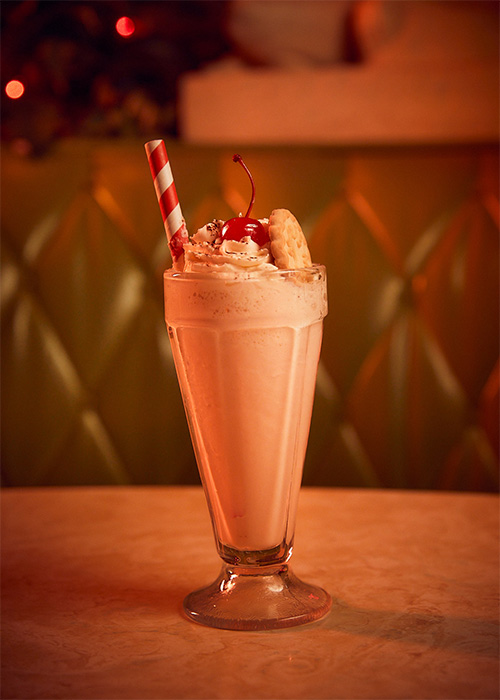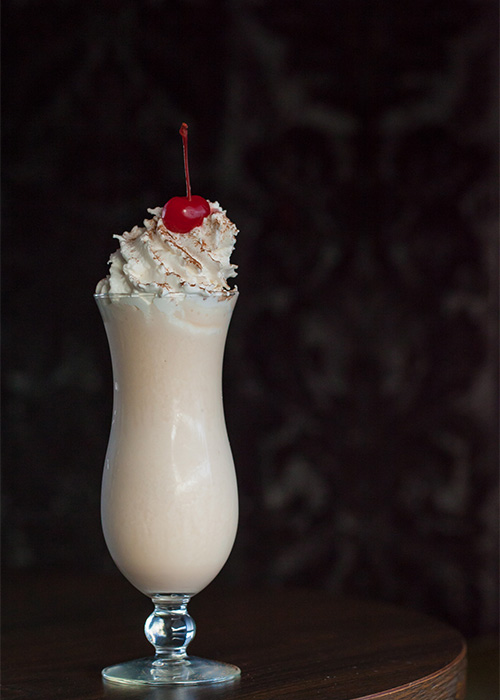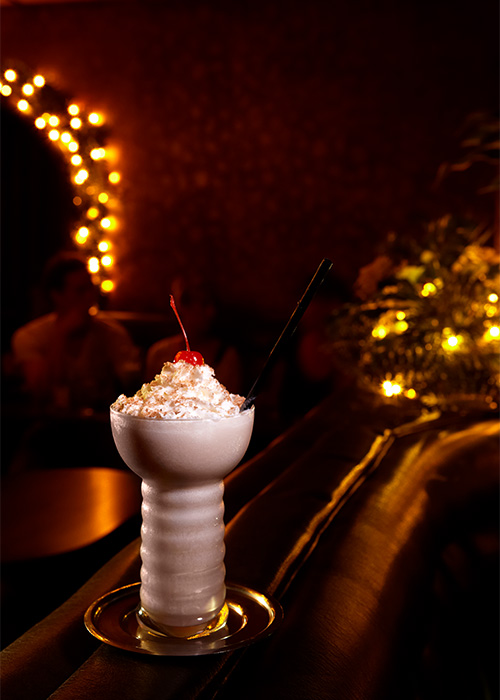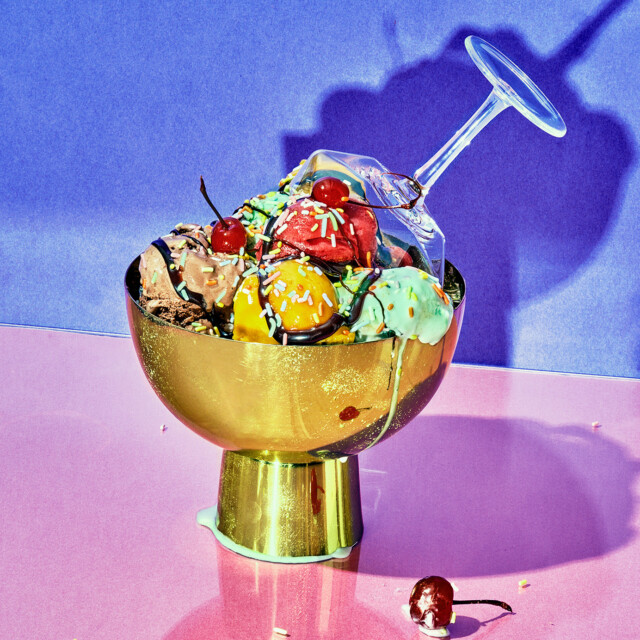My last ice cream cocktail was a Brandy Alexander, which I sipped at the bar inside a 175-year-old supper club and former inn in southeastern Wisconsin. It tasted like a posh dark chocolate milkshake with a boozy edge, sporting a creamy texture as soft as silk. But the place where I drank it might matter more.
The Wilmot Stage Stop, set in an old clapboard manor, looks just as you might imagine: ensconced in carpeting, striped wallpaper, and exposed stone, and bedecked with bric-a-brac, old framed flyers, and black-and-white photos of so-and-so’s who’ve passed through over the decades. As an almost lifelong Midwesterner and graduate of the University of Wisconsin-Madison with a penchant for old neighborhood joints, places like this draw me in like a moth to a flame. Indeed, it doesn’t get older or jointier than a real Wisconsin supper club.
For the uninitiated, the wanton rules of such establishments are simple: Dinner is implicitly progressive, meaning we begin in the bar with sugared Brandy Old Fashioneds and perhaps a relish tray, then we migrate to the table for steaks and potatoes heaped with sour cream before finishing the night with ice cream cocktails.
The Stage Stop makes no secret that dairy factors heavily into its modus operandi, from the moment patrons sit down and servers deliver a brick-shaped pound of butter with each bread basket. Yet even more than its butter-smeared ribeyes (add a lobster tail for $12.95!) and sour-cream-doused potatoes, the Stage Stop draws praise for its silky Grasshoppers and Brandy Alexanders, whizzed up with topnotch Wisconsin-made vanilla ice cream and generous splashes of middling liquor, then heaped into bulbous wine glasses with whipped cream and sprinkles.

My companions and I dutifully sipped our hedonistic milkshakes while the bartender regaled us with the various places throughout the old inn where he swears he’s seen or heard its supposed resident ghost. As a pleasant buzz set in (no doubt buoyed by my earlier Old Fashioneds), I idly wondered whether the ice cream cocktail is a categorically good drink or if I’m just intoxicated by the experience of sipping it in a place that remains similarly frozen in time. In other words, can I separate the drink from the nostalgia?
“Are ice cream cocktails actually good?” Milwaukee-born drinks writer and author Robert Simonson pensively repeats my question back after I pose it. Simonson enjoys the occasional ice cream cocktail, too. Though, like me, he pretty much only orders them on return trips to Wisconsin. “I think they’re good. It’s just one of those specialties of the state, like a Brandy Old Fashioned,” he says. “You feel duty bound to have one, and they do them well.”
Ice cream cocktails date back at least as far as before the Second World War, according to food and beverage writer Jeanette Hurt, who wrote the 2020 book, “Wisconsin Cocktails.” Cream-based drinks existed before then, of course. For example, Difford’s Guide traces the Brandy Alexander (also known as Alexander #2) to at least the late 1920s, since the drink appeared in Harry Craddock’s 1930 “The Savoy Cocktail Book.”
We don’t know for sure who was the first to sub in ice cream for the heavy cream, but few places have embraced it like the state of Wisconsin. Hurt outlines numerous reasons why in her book. While America’s dairyland produces plenty of heavy cream and half-and-half, Wisconsin makes (and promotes) a lot more ice cream and frozen custard. Indeed, the city of Two Rivers lays claim to the first ice-cream sundae, she writes.
Per Simonson, good ice cream — and lots of it — provides the foundation of the drink. “I seem to have the feeling that you can’t make a good ice cream cocktail with bad ice cream; it doesn’t come together,” he says. On the other hand, the alcohol — as in cheap Crème de Menthe and well Brandy — is rightly an afterthought, drizzled over top.
The other crucial element in a good ice cream cocktail is achieving a smooth and creamy texture, whether you’re whipping the ice cream by hand (as they still do at Simonson’s beloved HobNob supper club in Racine), or in a blender — an appliance that unsurprisingly originated in Wisconsin, too.
In 1922, a Polish immigrant in Racine named Stephen Poplawski received a patent for a blender he designed with an agitating element mounted in a base adapted to be connected with the agitator in the cup. He later patented the home mixer in 1940 and eventually sold his business to the John Oster Manufacturing Co. in 1946, which renamed the mixer the Osterizer. (Racine and milkshakes go back even further, to 1884 when an inventor named James Tufts patented a crank-operated mixer called the Lightning Shaker, which he specifically designed to produce milkshakes.)

Since the 1950s the Osterizers have been humming almost ceaselessly at Bryant’s Cocktail Lounge, which Bryant Sharpe opened in a former Milwaukee tied house in 1936. (A tied house was a pre-Prohibition saloon required to buy at least some of its beer from a particular brewery or pub company.) Two years later, Sharpe turned it into the city’s first bona fide cocktail bar. There he claimed to have later invented the Banshee (vodka, banana liqueur, and white crème de cacao), Blue Tail Fly (blue curaçao and crème de cacao), and the Pink Squirrel (Crème de Noyaux and crème de cacao) ice cream cocktails. Simonson casts doubt on the last claim.
“There is proof that there was a stunt that was pulled in 1951 by [Crème de Noyaux maker and Dutch distiller] Bols Co.,” Simonson says. “They had an actress go to clubs around town with a squirrel painted pink and ask bartenders for a Pink Squirrel cocktail, which they did not know of. It made the papers, and after that bars started serving Pink Squirrels.”
Bryant’s current owner John Dye, counters that Sharpe in fact worked with Bols that same year to invent the cocktail, citing articles dating back to the 1980s. “The old manager, Shirley Lafferty, now 93, came on right after Bryant died and worked there for like 50 years, so she has that direct connection to him,” he says.
This is just the sort of lore I’d enjoy parsing while I sip Dye’s Pink Squirrel, now made with small-batch Cedar Crest ice cream blended with almondy Crème de Noyaux and crème de cacao — “we modify the Noyaux a little because of the flavor profile of the ice cream,” he says — then topped with whipped cream and a confoundingly red cherry. Dye also owns At Random, the ‘60s born, redlit cocktail lounge that has since overtaken Bryant’s as the Milwaukee destination for ice cream cocktails. Curiously, more people order them in winter than in summer, reinforcing Dye’s theory that the drinks’ enduring popularity owes to the “cozy nostalgia” they deliver rather than the refreshment of a milkshake on a hot summer night.

“I find ice cream cocktails to be charming and just a real unique piece of Wisconsin,” says Dye, who favors the Golden Cadillac, by the way, for its booziness and complexity from the addition of herbaceous Galliano liqueur. “People in Wisconsin can take anything that’s bad for you and make it worse for you,” he says. “They’ll take a burger and put butter on there, or take ice cream and put booze in there. It’s a beautiful place.”
Maybe that’s why I could never bring myself to order an ice cream cocktail from a posh cocktail lounge — and why it’s rare for Simonson, too.
“You can probably get an ice cream cocktail at one of these fancy craft cocktail bars, but you’re going to be missing that cozy feeling,” Simonson says. “When I think about having an ice cream cocktail, I think about being in one of those places that’s trapped in the 1950s or ‘60s when these drinks were created. It’s that taste memory kind of thing.”
In that sense, it doesn’t really matter if ice cream cocktails are categorically “good.” As for me, I’ve determined that these dessert drinks are about the place after all — ideally the low-lit, timeworn sort haunted by ghosts who like playing with light switches and whispering tall tales of cocktail origins into the ears of patrons whose judgment was long ago compromised by copious amounts of cheap brandy and damn good ice cream.
Long live the Wisconsin supper club.
